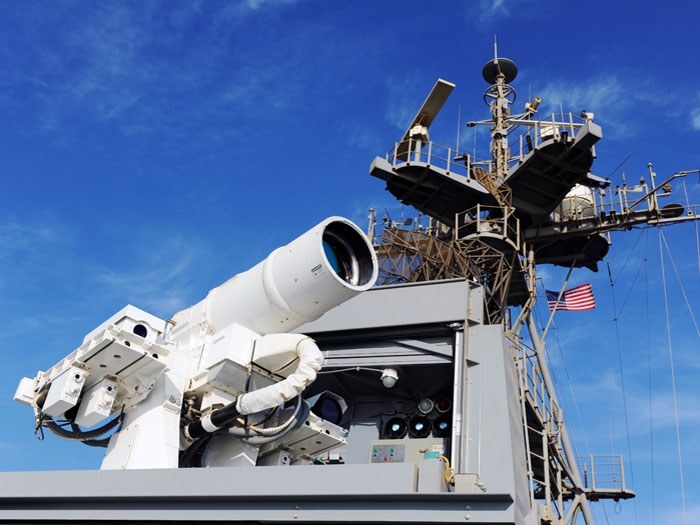
U.S. Navy tests “Star Wars” technology at sea
Written by Marine Log Staff
The Laser Weapons System (LaWS) tested on the USS Ponce
DECEMBER 12, 2014—Zapping enemy planes, ships and boats with lasers may seem like something straight out of Star Wars, but the U.S. Navy inched a step closer to that reality during a recent demonstration on board a naval ship in the Arabian Gulf. The laser weapon system could be deployed on guided missile destroyers and Littoral Combat Ships in the early 2020’s.
The deployment and testing of the (Laser Weapons System (LaWS) on board the Austin Clas amphibious transport dock ship USS Once (AFSB(1) 15) was announced by officials from the Office of Naval Research (ONR), Arlington, VA. During the tests, LaWS was used to hit targets mounted on a speeding oncoming small boat, shot down a Scan Eagle unmanned aerial vehicle (UAV), and destroy ordnance on an unmanned surface vehicle.
The project was a collaborative effort between ONR, Naval Sea Systems Command, Naval Research Laboratory, Naval Surface Warfare Center Dahlgren Division and industry partners
The ONR called the demonstration on the USS Ponce “historic” because it not only showed a laser weapon working aboard a deployed U.S. Navy ship, but also because LaWS operated seamlessly with existing ship defense systems.
“Laser weapons are powerful, affordable and will play a vital role in the future of naval combat operations,” said Rear Adm. Matthew L. Klunder, chief of naval research. “We ran this particular weapon, a prototype, through some extremely tough paces, and it locked on and destroyed the targets we designated with near-instantaneous lethality.”
ONR says that sailors on the USS Ponce worked daily with LaWS over several months, and reported the weapon performed flawlessly, including in adverse weather conditions of high winds, heat and humidity. They noted the system exceeded expectations for both reliability and maintainability.
As you can see in the accompanying video, the system is operated using a video-game like controller, and can address multiple threats using a range of escalating options, from non-lethal measures such as optical “dazzling” and disabling, to lethal destruction if necessary. It could prove to be a pivotal asset against what are termed “asymmetric threats,” which include small attack boats and UAVs.
Data regarding accuracy, lethality and other factors from the deployment on USS Ponce will guide the development of weapons under ONR’s Solid-State Laser-Technology Maturation program. Under this program, industry teams have been selected to develop cost-effective, combat-ready laser prototypes that could be installed on vessels such as guided-missile destroyers and the Littoral Combat Ship in the early 2020s.
Researchers say the revolutionary technology breakthroughs demonstrated by LaWS will ultimately benefit not only U.S. Navy surface ships, but also airborne and ground-based weapon systems.
While laser weapons offer new levels of precision and speed for naval warfighters, they also bring increased safety for ships and crews, as lasers are not dependent on the traditional propellant and gunpowder-based ordnance found on ships. Lasers run on electricity and can be fired as long as there is power.
They also cost less to build, install and fire than traditional kinetic weapons—for example a multimillion-dollar missile.
“At less than a dollar per shot, there’s no question about the value LaWS provides,” said Klunder. “With affordability a serious concern for our defense budgets, this will more effectively manage resources to ensure our Sailors and Marines are never in a fair fight.”
The Navy already has demonstrated the effectiveness of lasers in a variety of maritime settings. In a 2011 demonstration, a laser was used to defeat multiple small boat threats from a destroyer. In 2012, LaWS downed several unmanned aircraft in tests during naval exercises. Specific details on next steps and timeframes are being determined as the data from the current demonstrations are analyzed.





Leave a Reply
You must be logged in to post a comment.